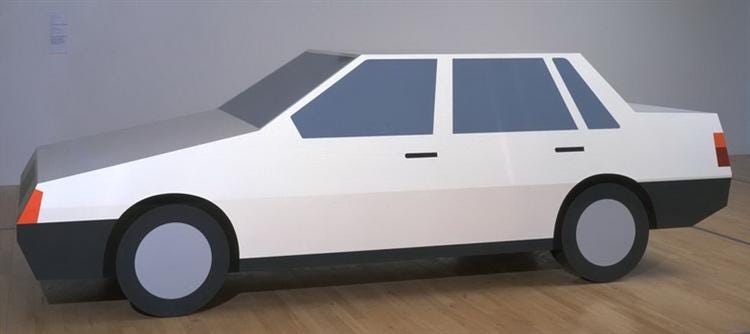#38 - Locomoting Through Time
The Crib-Jumper of Doom; Shoots and Ladders; Junkers and Clunkers
Hello, my friends,
Soccer is the world’s most popular sport (followed by cricket and hockey, by the way, which is wild from an American perspective) and I can understand why. It’s simple and fun, and all it requires is two people, a little space, and something to kick. From youthful experience, I can verify that even a soda can fits the bill. On Sunday, my friend Yago invited me to play a little pickup game in celebration of his birthday (which was on Tuesday) and I had so much fun that the next day I bought some shorts, two practice jerseys, a ball, and some cones. A basic web search revealed that there are free and low-cost pickup games fairly close to me (and all over Los Angeles) on every single night of the week — most popular game indeed! I played soccer on a practice team as a teenager so I’m not totally inexperienced but I do need practice. Suffice it to say that my legs and hips are still recovering from Sunday. More regular play should get them back into shape, though. Maybe I’ll even join a league someday!
The Crib-Jumper of Doom
Back when Michael was just shy of two years old, he figured out how to climb out of his crib. Parents know that every stage of a child’s locomotive expansion adds new stress to the job — when bread-loaf baby learns to turn, when baby squirrel begins to crawl, when sir or madam toddler starts to waddle, and so on, all force parents to lift the limitations off the youth and place it on themselves. To wit, when Michael began to vault himself out of his crib, our evenings (the only time when working parents get a little freedom) suddenly disappeared. Instead of reading a book, writing, or watching a movie, we were constantly interrupted by small child with undeveloped communication skills seeking attention just for existing. And he’d stay up until ten or eleven at night! It was awful! And that is not to mention that he could now get up in the middle of the night to do God knows what (read: Mostly wake us up). It was two torturous weeks until we relented and put a gate on his door.
Those two weeks from two years ago still haunt me. Well, you might guess what’s coming next: Young Sophie, having recently gained membership into Club Terrible Twos, has also achieved also lift-off! While she isn’t staying up as light as Michael, she has been climbing out of bed consecutively for up to an hour past her bedtime. The worst of it is night time; Monday to Tuesday night Sophie got out of bed at like 1 am wanting to play and wouldn’t take no for an answer. By the time I got her to bed it was an hour-and-a-half later and it wasn’t easy to get back to sleep. On Tuesday, I removed the wall of her crib in hopes that the lack of daring required to escape bed will lessen her thrill at appearing outside her bedroom over and over (it hasn’t). Hopefully, she’ll get back to her normal routine, but if not, a gate will be going up sooner than later.
I do have to say that the understanding that most parenting challenges are temporary definitely makes the second child easier. This is especially so if the second child is the Golden Apple (Sophie’s nickname at childcare).
Shoots and Ladders
On Sunday, I was on a step-ladder retrieving a water bottle from all the way in the back of the cupboard above the refrigerator when Michael saw me, and with incredulity in his voice stated, “Adults use ladders, too?”
“Sure,” I said, “how else would I get something all the way back there?”
Indeed, I’d say that us adults use ladders and other helpful tools even more than the kids do. We need help in our everyday lives, as seen in both meatspace and metaphor. I was surprised by Michael’s remark both because sometimes I forget that he’s four and has all sorts of interesting conceptions of how the universe sticks together, and because it hadn’t occurred to me that a child might see adults as infinitely tall, strong, and knowledgeable. On second thought, I don’t know if Michael sees all adults as equally tall and strong. Every time he sees my twin brother, Igor, he keeps trying to defeat him in combat.
Junkers and Clunkers
There are a few ways that you know you’re in an old car — I’m not talking about a restored classic, I’m talking about something from 1997 with a paint color that is best described as “overcast gray” or “barf blue,” the kind of car that no longer exists as a specific make and model but just gets filed under the generic category “car” — you know you’re in a car like because it sounds like someone popped the hood and dropped a bunch of marbles inside. Those marbles are everywhere — in the doors, in the trunk, in the glovebox. It’s like driving a pinball machine.
Even though the car has survived for 25 years and there’s no major problems, every trip feels like it could be the last one. Taking it for an oil change is full of suspense, like waiting for the results of a biopsy. Even if the mechanic gives it a clean bill of health you still want to ask “How long does she have?” No one knows! One day something could pop and it’s $2500 to replace. Then you weigh your options: If repaired that car could run for another five years! And it has so much sentimental value being older than most of Gen Z. But of course, the repair is worth more than the cost of the car.
Still, having an old car is liberating in a way. It gives you street cred. New cars these days barely let you drive them. Lane assist, rearview cameras, automatic climate control take away the thrill of little things like turning your head to see if there’s anyone in the lane next to you before switching lanes or, I don’t know, being hot by choice. I had to change the windshield on my car (a 2021 Prius) a few months ago and was shocked by the price. I don’t need special overlays, I said, I just want glass (preferably clear). No, the nice lady on the phone said, all the cars have that now. If the windshield doesn’t have the hookups then the computer won’t work. The conversation left my shook. What is the world coming to when they have to plug in my windshield!
So anyway, if you need to pay $2500 to repair your “gan-green” 1997 Toyota Corolla, just do it. Even if it sounds like your smoker neighbors fighting every time you turn the ignition.








Something very comfortable about a car whose hood you can open and identify the basic working parts.
I plan to drive my beloved 1997 RAV (The date is somewhat misleading because I bought it in 2011 with only 30,000 miles on it) until at least a million miles.
I have a rental car at the moment and it's reminding me that for all of its conveniences, it knows way too much.